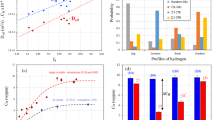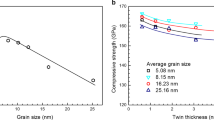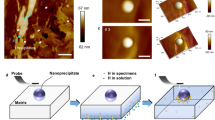Abstract
The interplay between hydrogen and nanovoids, despite long being recognized as a central factor in hydrogen-induced damage in structural materials, remains poorly understood. Here, focusing on tungsten as a model body-centred cubic system, we explicitly demonstrate sequential adsorption of hydrogen adatoms on Wigner–Seitz squares of nanovoids with distinct energy levels. Interaction between hydrogen adatoms on nanovoid surfaces is shown to be dominated by pairwise power-law repulsion. We establish a predictive model for quantitative determination of the configurations and energetics of hydrogen adatoms in nanovoids. This model, combined with the equation of states of hydrogen gas, enables the prediction of hydrogen molecule formation in nanovoids. Multiscale simulations, performed based on our model, show good agreement with recent thermal desorption experiments. This work clarifies fundamental physics and provides a full-scale predictive model for hydrogen trapping and bubbling in nanovoids, offering long-sought mechanistic insights that are crucial for understanding hydrogen-induced damage in structural materials.
This is a preview of subscription content, access via your institution
Access options
Access Nature and 54 other Nature Portfolio journals
Get Nature+, our best-value online-access subscription
$29.99 / 30 days
cancel any time
Subscribe to this journal
Receive 12 print issues and online access
$259.00 per year
only $21.58 per issue
Buy this article
- Purchase on Springer Link
- Instant access to full article PDF
Prices may be subject to local taxes which are calculated during checkout




Similar content being viewed by others
Data availability
The data generated and/or analysed within the current study will be made available upon reasonable request to the authors.
Code availability
The code for the object kinetic Monte Carlo simulations will be made available upon reasonable request to the authors.
References
Zhang, Z., Obasi, G., Morana, R. & Preuss, M. Hydrogen assisted crack initiation and propagation in a nickel-based superalloy. Acta Mater. 113, 272–283 (2016).
Song, J. & Curtin, W. A. Atomic mechanism and prediction of hydrogen embrittlement in iron. Nat. Mater. 12, 145–151 (2013).
Tiegel, M. C. et al. Crack and blister initiation and growth in purified iron due to hydrogen loading. Acta Mater. 115, 24–34 (2016).
Xie, D. G. et al. In situ study of the initiation of hydrogen bubbles at the aluminium metal/oxide interface. Nat. Mater. 14, 899–903 (2015).
Jia, Y. Z. et al. Subsurface deuterium bubble formation in W due to low-energy high flux deuterium plasma exposure. Nucl. Fusion 57, 034003 (2017).
Garner, F. A. et al. Retention of hydrogen in fcc metals irradiated at temperatures leading to high densities of bubbles or voids. J. Nucl. Mater. 356, 122–135 (2006).
Toda, H. et al. Growth behavior of hydrogen micropores in aluminum alloys during high-temperature exposure. Acta Mater. 57, 2277–2290 (2009).
Neeraj, T., Srinivasan, R. & Li, J. Hydrogen embrittlement of ferritic steels: observations on deformation microstructure, nanoscale dimples and failure by nanovoiding. Acta Mater. 60, 5160–5171 (2012).
Robertson, I. M. et al. Hydrogen embrittlement understood. Metall. Mater. Trans. B 46, 1085–1103 (2015).
Zhao, J. et al. Investigation of hydrogen bubbles behavior in tungsten by high-flux hydrogen implantation. J. Nucl. Mater. 503, 198–204 (2018).
Veen, A. V. et al. Hydrogen exchange with voids in tungsten observed with TDS and PA. J. Nucl. Mater. 155–157, 1113–1117 (1988).
Zibrov, M., Ryabtsev, S., Gasparyan, Y. & Pisarev, A. Experimental determination of the deuterium binding energy with vacancies in tungsten. J. Nucl. Mater. 477, 292–297 (2016).
Ryabtsev, S., Gasparyan, Y., Zibrov, M., Shubina, A. & Pisarev, A. Deuterium thermal desorption from vacancy clusters in tungsten. Nucl. Instrum. Methods Phys. Res. B 382, 101–104 (2016).
Ogorodnikova, O. V. et al. Surface modification and deuterium retention in reduced-activation steels under low-energy deuterium plasma exposure. Part II: Steels pre-damaged with 20 MeV W ions and high heat flux. Nucl. Fusion 57, 036011 (2017).
Zhu, X.-L. et al. Deuterium occupation of vacancy-type defects in argon-damaged tungsten exposed to high flux and low energy deuterium plasma. Nucl. Fusion 56, 036010 (2016).
Ogorodnikova, O. V., Roth, J. & Mayer, M. Ion-driven deuterium retention in tungsten. J. Appl. Phys. 103, 034902 (2008).
Guterl, J., Smirnov, R. D., Krasheninnikov, S. I., Zibrov, M. & Pisarev, A. A. Theoretical analysis of deuterium retention in tungsten plasma-facing components induced by various traps via thermal desorption spectroscopy. Nucl. Fusion 55, 093017 (2015).
Fu, C.-C., Torre, J. D., Willaime, F., Bocquet, J.-L. & Barbu, A. Multiscale modelling of defect kinetics in irradiated iron. Nat. Mater. 4, 68–74 (2004).
Valles, G. et al. Influence of grain boundaries on the radiation-induced defects and hydrogen in nanostructured and coarse-grained tungsten. Acta Mater. 122, 277–286 (2017).
De Backer, A. et al. Multiscale modelling of the interaction of hydrogen with interstitial defects and dislocations in bcc tungsten. Nucl. Fusion 58, 016006 (2018).
Liu, Y.-L., Zhang, Y., Zhou, H.-B. & Lu, G.-H. Vacancy trapping mechanism for hydrogen bubble formation in metal. Phys.Rev. B 79, 172103 (2009).
Xing, W. et al. Unified mechanism for hydrogen trapping at metal vacancies. Int. J. Hydrog. Energy 39, 11321–11327 (2014).
Ohsawa, K., Goto, J., Yamakami, M., Yamaguchi, M. & Yagi, M. Trapping of multiple hydrogen atoms in a tungsten monovacancy from first principles. Phys. Rev. B 82, 184117 (2010).
Ohsawa, K., Eguchi, K., Watanabe, H., Yamaguchi, M. & Yagi, M. Configuration and binding energy of multiple hydrogen atoms trapped in monovacancy in bcc transition metals. Phys. Rev. B 85, 094102 (2012).
You, Y.-W. et al. Dissolving, trapping and detrapping mechanisms of hydrogen in bcc and fcc transition metals. AIP Adv. 3, 012118 (2013).
Tanguy, D., Wang, Y. & Connétable, D. Stability of vacancy-hydrogen clusters in nickel from first-principles calculations. Acta Mater. 78, 135–143 (2014).
Gui, L.-J. et al. First-principles investigation on vacancy trapping behaviors of hydrogen in vanadium. J. Nucl. Mater. 442, S688–S693 (2013).
Kong, X.-S. et al. First-principles calculations of hydrogen solution and diffusion in tungsten: temperature and defect-trapping effects. Acta Mater. 84, 426–435 (2015).
Fernandez, N., Ferro, Y. & Kato, D. Hydrogen diffusion and vacancies formation in tungsten: density functional theory calculations and statistical models. Acta Mater. 94, 307–318 (2015).
Ismer, L., Park, M. S., Janotti, A. & Van de Walle, C. G. Interactions between hydrogen impurities and vacancies in Mg and Al: a comparative analysis based on density functional theory. Phys. Rev. B 80, 184110 (2009).
Tateyama, Y. & Ohno, T. Stability and clusterization of hydrogen-vacancy complexes in α−Fe: an ab initio study. Phys. Rev. B 67, 174105 (2003).
You, Y.-W. et al. Clustering of H and He, and their effects on vacancy evolution in tungsten in a fusion environment. Nucl. Fusion 54, 103007 (2014).
Lu, G. & Kaxiras, E. Hydrogen embrittlement of aluminum: the crucial role of vacancies. Phys. Rev. Lett. 94, 155501 (2005).
Monasterio, P. R., Lau, T. T., Yip, S. & Van Vliet, K. J. Hydrogen-vacancy interactions in Fe–C alloys. Phys. Rev. Lett. 103, 085501 (2009).
Hayward, E. & Fu, C.-C. Interplay between hydrogen and vacancies in α-Fe. Phys. Rev. B 87, 174103 (2013).
Hayward, E., Hayward, R. & Fu, C.-C. Predicting distinct regimes of hydrogen behavior at nano-cavities in metals. J. Nucl. Mater. 476, 36–44 (2016).
Geng, W. T. et al. Hydrogen bubble nucleation in α-iron. Scripta Mater. 134, 105–109 (2017).
Wang, L. F., Shu, X., Lu, G. H. & Gao, F. Embedded-atom method potential for modeling hydrogen and hydrogen–defect interaction in tungsten. J. Phys. Condens. Matter 29, 435401 (2017).
Cusentino, M. A., Hammond, K. D., Sefta, F., Juslin, N. & Wirth, B. D. A comparison of interatomic potentials for modeling tungsten–hydrogen–helium plasma–surface interactions. J. Nucl. Mater. 463, 347–350 (2015).
Brimbal, D. et al. Application of Raman spectroscopy to the study of hydrogen in an ion irradiated oxide-dispersion strengthened Fe–12Cr steel. J. Nucl. Mater. 447, 179–182 (2014).
Koch, S. J., Lavrov, E. V. & Weber, J. Towards understanding the hydrogen molecule in ZnO. Phys. Rev. B 90, 205212 (2014).
van de Walle, C. G. & P.Goss, J. Energetics and vibrational frequencies of interstitial H2 molecules in semiconductors. Mater. Sci. Eng. B 58, 17–23 (1999).
Christmann, K. Interaction of hydrogen with solid surfaces. Surf. Sci. Rep. 9, 1–163 (1988).
Einstein, T. L. in Handbook of Surface Science Vol. 1, 1st edn (ed. Unertl, W. N.) Ch. 11 (Elsevier, 1996).
Loubeyre, P. et al. X-ray diffraction and equation of state of hydrogen at megabar pressures. Nature 383, 702–704 (1996).
Shimizu, H. & Brody, E. M. Brillouin measurements of solid n-H2 and n-D2 to 200 kbar at room temperature. Phys. Rev. Lett. 47, 128–131 (1981).
Hemmes, H., Driessen, A. & Griessen, R. Thermodynamic properties of hydrogen at pressures up to 1 Mbar and temperatures between 100 and 1000 K. J. Phys. C 19, 3571–3585 (1986).
Becquart, C. S., Domain, C., Sarkar, U., DeBacker, A. & Hou, M. Microstructural evolution of irradiated tungsten: ab initio parameterisation of an OKMC model. J. Nucl. Mater. 403, 75–88 (2010).
Debelle, A., Barthe, M. F. & Sauvage, T. First temperature stage evolution of irradiation-induced defects in tungsten studied by positron annihilation spectroscopy. J. Nucl. Mater. 376, 216–221 (2008).
De Backer, A., Lhuillier, P. E., Becquart, C. S. & Barthe, M. F. Modelling of the implantation and the annealing stages of 800keV 3He implanted tungsten: formation of nanovoids in the near surface region. J. Nucl. Mater. 429, 78–91 (2012).
Kresse, G. & Hafner, J. Ab initio molecular dynamics for open-shell transition metals. Phys. Rev. B 48, 13115–13118 (1993).
Kresse, G. & Hafner, J. Ab initio molecular dynamics for liquid metals. Phys. Rev. B 47, 558–561 (1993).
Blöchl, P. E. Projector augmented-wave method. Phys. Rev. B 50, 17953–17979 (1994).
Perdew, J. P., Burke, K. & Ernzerhof, M. Generalized gradient approximation made simple. Phys. Rev. Lett. 77, 3865–3868 (1996).
Perdew, J. P. et al. Atoms, molecules, solids, and surfaces: applications of the generalized gradient approximation for exchange and correlation. Phys. Rev. B 46, 6671–6687 (1992).
Becquart, C. S. & Domain, C. Ab initio calculations about intrinsic point defects and He in W. Nucl. Instrum. Methods Phys. Res. B 255, 23–26 (2007).
Hou, J. et al. Modification on theory of sink strength: an object kinetic Monte Carlo study. Comput. Mater. Sci. 123, 148–157 (2016).
Hou, J. et al. Hydrogen bubble nucleation by self-clustering: density functional theory and statistical model studies using tungsten as a model system. Nucl. Fusion 58, 096021 (2018).
Li, Y. G. et al. IM3D: a parallel Monte Carlo code for efficient simulations of primary radiation displacements and damage in 3D geometry. Sci. Rep. 5, 18130 (2015).
Acknowledgements
The authors thank Y. Li at the Institute of Solid State Physics, Chinese Academy of Sciences for providing the IM3D primary irradiation damage data. The authors are grateful for valuable comments and discussion from G. Lu at Beihang University and W. Han at Xi’an Jiaotong University, and also thank G. Lu for providing the empirical-potential-based hydrogen trapping data from his earlier work. This work was financially supported by the National Magnetic Confinement Fusion Energy Research Project (grant no. 2015GB112001), the National Key R&D Program of China (grant no. 2018YFE0308102), the National Natural Science Foundation of China (nos. 11735015, 51771185 and 11575229) and the Natural Sciences and Engineering Research Council of Canada Discovery grant no. RGPIN-2017-05187. J.H. acknowledges financial support from the China Scholarship Council (CSC). J.H. and J.S. acknowledge the Supercomputer Consortium Laval UQAM McGill and Eastern Quebec for providing computing resources. X.W. acknowledges support from the Youth Innovation Promotion Association of CAS (2015384).
Author information
Authors and Affiliations
Contributions
J.S. and X.W. conceived the original idea and designed the work. X.S.K. and J.H. conducted the simulations with help from C.S.L. All authors wrote the paper and discussed the results. C.S.L. and J.S. supervised the project.
Corresponding authors
Ethics declarations
Competing interests
The authors declare no competing interests.
Additional information
Publisher’s note: Springer Nature remains neutral with regard to jurisdictional claims in published maps and institutional affiliations.
Supplementary information
Supplementary Information
Supplementary Figs. 1–19, Supplementary Tables 1–5, Supplementary references 1–19
Rights and permissions
About this article
Cite this article
Hou, J., Kong, XS., Wu, X. et al. Predictive model of hydrogen trapping and bubbling in nanovoids in bcc metals. Nat. Mater. 18, 833–839 (2019). https://doi.org/10.1038/s41563-019-0422-4
Received:
Accepted:
Published:
Issue Date:
DOI: https://doi.org/10.1038/s41563-019-0422-4
This article is cited by
-
Switching nanoprecipitates to resist hydrogen embrittlement in high-strength aluminum alloys
Nature Communications (2022)
-
Role of hydrogen in stability and mobility of vacancy clusters in tungsten
Tungsten (2022)
-
Progress on material characterization methods under big data environment
Advanced Composites and Hybrid Materials (2021)
-
Interpreting nanovoids in atom probe tomography data for accurate local compositional measurements
Nature Communications (2020)
-
A review of surface damage/microstructures and their effects on hydrogen/helium retention in tungsten
Tungsten (2020)



